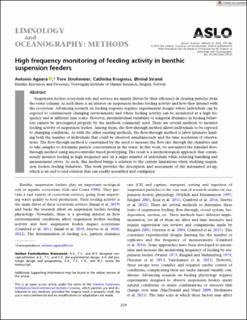| dc.contributor.author | Aguera, Antonio | |
| dc.contributor.author | Strohmeier, Tore | |
| dc.contributor.author | Krogness, Cathinka M. | |
| dc.contributor.author | Strand, Øivind | |
| dc.date.accessioned | 2023-11-03T10:44:08Z | |
| dc.date.available | 2023-11-03T10:44:08Z | |
| dc.date.created | 2023-05-09T14:22:05Z | |
| dc.date.issued | 2023 | |
| dc.identifier.citation | Limnology and Oceanography : Methods. 2023, 21 (5), 243-295. | en_US |
| dc.identifier.issn | 1541-5856 | |
| dc.identifier.uri | https://hdl.handle.net/11250/3100495 | |
| dc.description.abstract | Suspension feeders ecosystem role and services are mainly driven by their efficiency in clearing particles from the water column. As such there is an interest on suspension feeders feeding activity and how they interact with the ecosystem. Advancing research on feeding response requires experimental designs where individuals can be exposed to continuously changing environments and where feeding activity can be monitored at a high frequency and at different time scales. However, interindividual variability or temporal dynamics in feeding behaviors cannot be investigated properly by the methods commonly used. There are several methods to monitor feeding activity of suspension feeders. Among them, the flow-through method allows individuals to be exposed to changing conditions. As with the other existing methods, the flow-through method is labor intensive limiting both the number of individuals that could be observed simultaneously and the time resolution of observations. The flow-through method is constrained by the need to measure the flow rate through the chambers and to take samples to determine particle concentration in the water. In this work, we automated the standard flow-through method using microcontroller based prototyping. The result is a methodological approach that continuously monitor feeding at high frequency and on a larger number of individuals while reducing handling and measurement errors. As such, this method brings a solution to the current limitations when studying suspension feeders feeding behaviors. This work provides the description and assessment of the automated set-up, which is an end to end solution that can readily assembled and configured. | en_US |
| dc.language.iso | eng | en_US |
| dc.title | High frequency monitoring of feeding activity in benthic suspension feeders | en_US |
| dc.title.alternative | High frequency monitoring of feeding activity in benthic suspension feeders | en_US |
| dc.type | Peer reviewed | en_US |
| dc.type | Journal article | en_US |
| dc.description.version | publishedVersion | en_US |
| dc.source.pagenumber | 243-295 | en_US |
| dc.source.volume | 21 | en_US |
| dc.source.journal | Limnology and Oceanography : Methods | en_US |
| dc.source.issue | 5 | en_US |
| dc.identifier.doi | 10.1002/lom3.10543 | |
| dc.identifier.cristin | 2146481 | |
| dc.relation.project | Norges forskningsråd: 299554 | en_US |
| dc.relation.project | Havforskningsinstituttet: 15195 | en_US |
| cristin.ispublished | true | |
| cristin.fulltext | original | |
| cristin.qualitycode | 1 | |
